Of all the really REALLY stupid ideas, they’ve been trying to create a human brain within a computer. They didn’t even ask the obvious question: is it even POSSIBLE to mimic the human brain in a computer? Heck, nothing has yet passed the famous Turing test (named after Alan Turing, the computer wizard in the movie Imitation Game). This test requires that the computer fool anyone interacting with it into believing that it’s a human being, not a machine.¹
Sir Roger Penrose, a British mathematician, mathematical physicist, philosopher of science and Nobel Laureate in Physics has stated clearly that our brains and computers are a mis-match, despite some outward similarities; the brain doesn’t really run on algorithms, like a computer. There is that extra “human” element. I’d go with Penrose every time; he’s a genius in every sense.
 Sir Roger Penrose
Sir Roger Penrose
But I would go further and state plainly that the “mind” is a non-material phenomenon and has nothing whatever to do with “stuff”, electronics, computers or squidge inside the skull (brain).
Notwithstanding, for 10 years, around 500 scientists and a cost of some €600 million, the so-called Human Brain Project—one of the biggest research endeavors ever funded by the European Union—has been running and is now coming to an end.
The conclusions? There are none (none worthwhile, anyway). It’s a bust!
During its run, scientists under the umbrella of the Human Brain Project (HBP) have published thousands of papers and made significant strides in neuroscience, such as creating detailed 3D maps of at least 200 brain regions, developing brain implants to treat blindness and using supercomputers to model functions such as memory and consciousness and to advance treatments for various brain conditions.
All good. But getting to terms with the way the human brain actually WORKS… Nada. Zilch. Bupkis.
The project did not achieve its goal of remodelling (simulating) the whole human brain—an aim that many scientists regarded as far-fetched in the first place. It changed direction several times, and its scientific output became “fragmented and mosaic-like”, says HBP member Yves Frégnac, a cognitive scientist and director of research at the French national research agency CNRS in Paris. For him, the project has fallen short of providing a comprehensive or original understanding of the brain. “I don’t see the brain; I see bits of the brain,” says Frégnac.²
See, the trouble is they don’t get the fundamental: they still think our mind is brain and the brain is synonymous with “mind”. That’s despite all the evidence to the contrary. It’s like equating bacteria with lemon trees… you’re not going to understand the infectious process of microbes that way… not EVER.
Yes, you might discover some interesting fruit flavors and get a good take on gin and tonic. And that’s really all that has happened.
Right from the start, there was trouble. Founder and former director, neuroscientist Henry Markram at the Swiss Federal Institute of Technology in Lausanne (EPFL), claimed that the HBP would be able to reconstruct and simulate the human brain at a cellular level, within a decade.
This outrageous claim was widely scoffed at: “It’s crap,” said one fellow neuroscientist, which just about set the tone.³
Maybe it was necessary argues friendlier sources:
“It’s not clear that the HBP would have got funded without some kind of ridiculously ambitious goal attached to it,” says Timothy O’Leary (no, not that Timothy O’Leary, he’s dead) a computational neuroscientist at the University of Cambridge, UK, who is not part of the HBP.
Ultimately, said Markram, the HBP would even help researchers to grapple with disorders such as Alzheimer’s disease. “If we don’t have an integrated view, we won’t understand these diseases,” he declared.
 Henry Markham
Henry Markham
But over time, it became clear that Markram was a poor leader. He kept moving the goal posts, cutting out a swathe of research on cognitive neuroscience that resulted in a network of 18 laboratories leaving the project. Eventually, more than 150 scientists signed a protest letter, urging the European Commission to reconsider the HBP’s purpose in time for the second round of funding.4
As a result, the EU formed a committee of independent specialists to look at how the project was being run and to revise its scientific objectives. The committee recommended that the HBP should re-evaluate and more sharply articulate its scientific goals, as well as re-integrate cognitive and systems neurosciences into its core program.
In February 2015, the HBP’s board of directors voted to disband the three-person executive committee and replace it with a larger board. Markham was out.
So Was Anything Achieved?
You bet. But nothing like the original Markham goal.
We have EBRAINS: a suite of tools and imaging data that scientists around the world can use to run simulations and digital experiments. But the future even for this project is not secure.
By creating and combining 3D maps of around 200 cerebral-cortex and deeper brain structures, HBP scientists made the Human Brain Atlas, which is accessible through EBRAINS. The atlas depicts the multilevel organization of the brain, from its cellular and molecular architecture to its functional modules and connectivity.
Using the atlas, HBP scientists have identified six previously unknown brain regions in the prefrontal cortex that contribute to memory, language, attention and music processing.5
It also links its maps to gene-expression data in the Allen Human Brain Atlas, a database developed by the Allen Institute for Brain Science in Seattle, Washington, that characterizes neurons across the brain. Using the paired atlases, researchers revealed how changes in gene expression associated with depression were linked to structural and functional changes in a region of the frontal cortex.6
HBP researchers have also developed unique algorithms that can build a full-scale scaffold model of brain regions from microscopy images. Using this tool, researchers have produced a detailed map of the CA1 region in the hippocampus, an area that is important for memory. The map contains around 5 million neurons and 40 billion synapses.7
Meanwhile, large brain projects launched or kicked into high gear elsewhere. The United States and Japan both launched brain projects around the same time as the HBP — the former will continue until 2026 and the latter is hoping to run for a total of 15 years. China’s brain project started in 2021, and Australia’s and South Korea’s projects have both entered their seventh year.8
A clinical trial called EPINOV has been able to pinpoint the origin of certain seizures in patients and much improve the accuracy of surgery for epilepsy, which probably couldn’t have happened without EBRAINS.
So there are fragmentary achievements but nothing like the original “goal”. David Hansel, a neuroscientist at the Integrative Neuroscience and Cognition Center in Paris, who wasn’t part of the project, says the HBP’s lack of prioritization and limited collaboration meant that it failed to capitalize on its size and to really unite the neuroscience community behind a common aim. “It did not have a list of top and reasonable questions to address.”
I wouldn’t hold your breath thinking computers are wonderful and they will probably understand the non-material world one day. How? Computers cannot connect with the non-material. Computers were created BY the non-material: by human minds! However fast and smart, they are a level BELOW us!
Prof.
References:
- https://www.investopedia.com/terms/t/turing-test.asp
- https://www.nature.com/articles/d41586-023-02600-x
- https://www.nature.com/articles/482456a
- Waldrop, M. Computer modelling: Brain in a box. Nature482, 456–458 (2012). https://doi.org/10.1038/482456a
- Ruland, S. et al. Cortex 153, 235–256 (2022)
- Bludau, S. et al. Am. J. Psychiatry 173, 291–298 (2016)
- Gandolfi, D. et al. Nature Comput. Sci. 3, 264–276 (2023)
- https://www.nature.com/articles/d41586-018-04122-3
The post Brain in A Box? I Don’t Think So appeared first on Dr. Keith Scott-Mumby.
